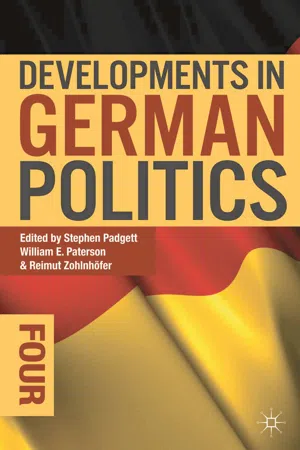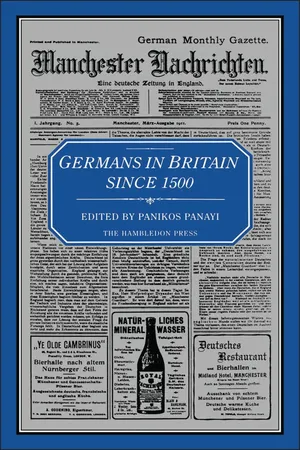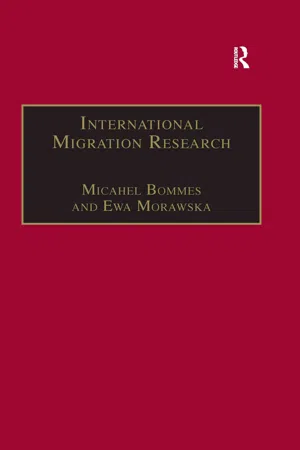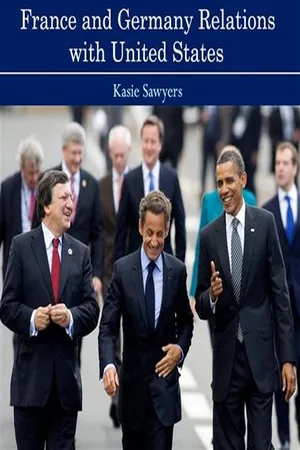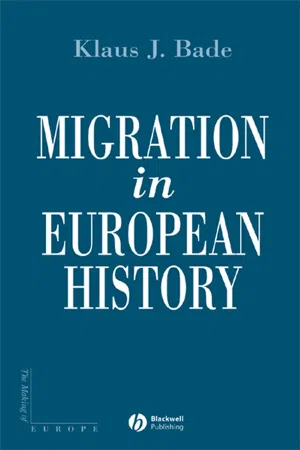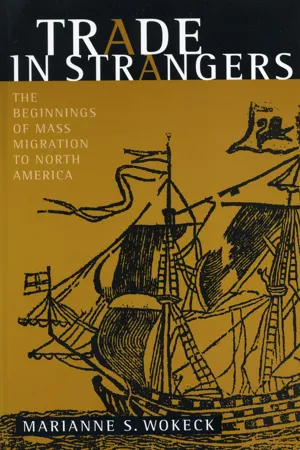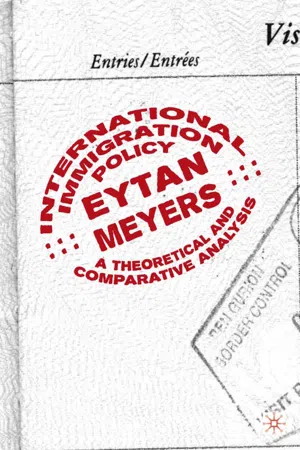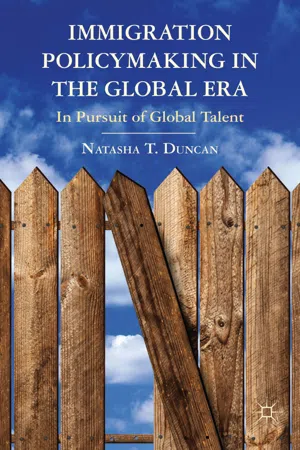History
German Immigration
German immigration refers to the movement of people from Germany to other countries, particularly the United States, during various periods of history. Significant waves of German immigration occurred in the 19th and early 20th centuries, contributing to the cultural and economic development of the receiving countries. German immigrants often settled in communities where they preserved their language, traditions, and customs.
Written by Perlego with AI-assistance
Related key terms
1 of 5
12 Key excerpts on "German Immigration"
- eBook - PDF
- Stephen Padgett, William E. Paterson, Reimut Zohlnhöfer, Stephen Padgett, William E. Paterson, Reimut Zohlnhöfer(Authors)
- 2014(Publication Date)
- Red Globe Press(Publisher)
Yet at the same time, immigration is not static but evolves over time, thereby creating a significant challenge for policy-makers. Other European coun-tries face a similar challenge, but it is particularly acute in Germany, both because of the range of policy issues to be resolved and the levels of immi-gration it has experienced. Especially since 1998, German policy-makers have attempted to meet this challenge by matching the policy framework to the reality of immigration as well as the changing needs and priorities of the German economy. In this chapter I explain these shifts in the policy 262 and politics of immigration, focusing on the reassessment of labour migration and the quest for integration and citizenship. I go on to discuss the related issues of ethnic Germans, asylum and family reunification, before concluding with a reflection on the future trajectory of this policy domain. First, though, we need to understand the historical context, and it is here that the chapter begins. Historical background Immigration in post-war Germany has taken two main forms. First, ethnic German migrants from eastern Europe and the Soviet Union were given the right to immigrate to and settle in West Germany, and over 4.5 million persons have done so since 1950. Second, labour migrants (so-called ‘guestworkers’ or Gastarbeiter ) were recruited by West German companies from southern Europe and the Mediterranean between 1955 and 1973. Thereafter, they were followed by their dependants and, after 1980, growing numbers of asylum seekers. By 1989, some 4.8 million persons without German nationality ( Ausländer ), comprising 7.7 per cent of the total population, lived in West Germany (Marshall, 1992; Herbert, 2001; Green, 2003). Immigration increased strongly with German unification. Between 1989 and 1993, over 1.4 million ethnic Germans arrived in the country; in addition, over 1.2 million asylum applications were lodged between 1990 and 1993, with over 438,000 in 1992 alone. - eBook - PDF
- Panikos Panayi(Author)
- 1996(Publication Date)
- Hambledon Continuum(Publisher)
The following chapter stresses the differences which existed amongst the nineteenth-century Germans in Britain and has four parts. The first exam-ines the reasons for immigration. The next deals with the structure of the nineteenth-century German communities, focusing especially upon geo- 74 Germans in Britain graphical and occupational distribution. The third section examines the richness and variety of ethnic activity amongst the Germans in nineteenth-century Britain, focusing upon the ethnic organisations which developed. The last theme is the growth of hostility in the late Victorian and Edward-ian years, which provided the background for the intense Germanophobia which gripped Britain during the First World War. The number of Germans who entered Britain between 1815 and 1914 probably exceeded the entire total who made their way to the country during the previous thousand years. However, attempting to explain the reasons for the nineteenth-century influxes proves difficult and we need a theoretical background to avoid a purely descriptive account. Rather than accepting traditional 2 or Marxist arguments, 3 we can best construct a new theoretical framework which recognises the existence of push, enabling and pull factors, which are further conditioned by the nature of the migration, whether economic or political, and which accepts three levels of causation: underlying, medium-term and personal. These ideas do not represent a model, they simply allow for a structured understanding of the reasons for German migration to Britain. We can begin with economic causation, focusing initially upon push factors. The most fundamental socio-economic development in nineteenth-century Germany, and the deepest underlying factor for the process of emigration, was the enormous expansion in population which meant an increase from 24,831,000 in 1816 to 64,568,000 in 1910, using the German boundaries of 1910. 4 The consequences of this growth were overpopulation on the land. - eBook - ePub
Religion, Identity and Politics
Germany and Turkey in Interaction
- Haldun Gülalp, Günter Seufert(Authors)
- 2013(Publication Date)
- Routledge(Publisher)
Immigration and immigrants in Germany have a history that goes much further back than that of labour immigration. During the late nineteenth and early twentieth centuries, approximately 6 million people of German origin emigrated from Europe to other continents, mainly to America. At the beginning of the twentieth century there was a wave of immigration into Germany from Poland and Italy. However, contemporary allusions to immigrants in Germany primarily refer to those who have arrived in the country from the 1950s onwards. We can roughly divide this 60-year period into five phases.During the first decades, the period until the mid-1970s, immigrants were of ‘guest worker’ status in the real sense of the term, and the question of integration had not at all emerged in the public sphere. The idea that they were in Germany only temporarily for work was widely shared by both the successive German governments and the immigrants themselves, who worked in factories and resided in workers’ dormitories, and even in barracks left over from World War II.The second period was inaugurated and shaped by the 1974 decision to stop recruiting guest workers, after which many workers brought their families over to Germany. Nevertheless, until the early 1980s, the great majority of immigrants of Turkish origin lived and shaped their lives according to the perception that they would return to Turkey, a perception that was again shared by the German government. That meant that the German government, the immigrants, and the Turkish government did not pay enough attention to questions of integration, education, and other such problems.During the period from the mid-1980s to the 1990s, which can be identified as the third phase, immigration became a highly politicized issue. The principal slogan of the 1980s immigration policy was ‘encouraging return’. A distinctly racist discourse was advanced by conservative politicians, as well as right-wing intellectuals. One is reminded of a proposal by Frankfurt’s Christian Democrat Mayor, Walter Wallmann, in 1982: if the city’s immigrant population were to reach above 30 per cent of the overall figure, he suggested, a settlement ban could be imposed on immigrants in order to prevent further settlement. This and other similar proposals of that period seem absurd today when 40 per cent of Frankfurt’s population is of immigrant origin, though back then such political statements instigated fear and xenophobia among the native population, while destroying the possibility of any sense of belonging among immigrants and confining them to a minority mind-set. - eBook - ePub
Foreigners, minorities and integration
The Muslim immigrant experience in Britain and Germany
- Sarah Hackett(Author)
- 2015(Publication Date)
- Manchester University Press(Publisher)
IntroductionA history of immigration to modern Britain and Germany: national and local perspectives The national contextsThe history of immigration to Britain and West Germany in the postwar period has traditionally been seen as one of contrasts.1 The reasons for this were not new to the post-1945 era, but rather were entrenched in both countries’ histories. Britain has often been perceived as a country with a long tradition of migration and one that was perhaps destined to become multi-racial. The black soldiers who fought in the Roman armies that invaded Britain, the migrants who arrived from the Indian subcontinent during the 1600s and 1700s, and the Yemeni seamen who settled in dockland areas from the mid-nineteenth century act as testimony to this.2 Furthermore, the British Empire ensured that people from all corners of the globe felt a connection with the ‘mother country’. Indeed Britain’s role as the imperial hub for a quarter of the world’s surface guaranteed a widespread familiarity with the British language, education system and way of life.3 Germany, by contrast, is a young country that, following its unification in 1871, displayed both nationalistic and racial ideology. In its short history, the notions of race and minority groups have never been far from its political agenda, whether in the form of racial hierarchy, exclusion and persecution, or xenophobia and discrimination.4Other contrasts between Britain and Germany’s immigration histories also exist and have been well documented in the historiography. Starting with its unification, Germany implemented a policy of Germanisation, the legacy of which lasted throughout the twentieth century. Furthermore, its völkisch ethno-cultural nationhood arguably shaped a national identity that limited the recognition of foreigners in the country. This was further accentuated by its status as the only major European immigration country with a pure jus sanguinis notion of citizenship. Britain’s imperial policy, on the contrary, whilst undoubtedly based on a racial hierarchy to some extent, never widely consisted of overt racial persecution. Furthermore, British citizenship was comparably more accessible as a result of the concept of jus soli , allowing immigrants to become integrated. In essence, by the second half of the twentieth century, Britain had a strong multi-ethnic tradition to act as the foundation for post-1945 immigration whilst Germany did not.5 - eBook - ePub
Immigration in the 21st Century
The Comparative Politics of Immigration Policy
- Terri Givens, Rachel Navarre, Terri E. Givens, Pete Mohanty(Authors)
- 2020(Publication Date)
- Routledge(Publisher)
5Immigration POLITICS
Germany and Newer Countries of Immigration
Introduction
As noted in Chapter 4 , the aftermath of World War II led to immigration from former colonies to France and Britain. For other countries that did not have the same kind of colonial ties, the first flows after the war came from other parts of Europe, but as countries like Germany began to recover from the war, they reached out to other countries like Turkey for the workers they needed to rebuild. These “newer” countries of immigration initially focused on labor flows, particularly during the 1950s and 1960s. It wasn’t until the 1970s and 1980s that they began to grapple with the fact that communities had developed, and the laborers had become settlers.Germany
After World War II, Germany struggled to recover from the devastation wrought by the war. Since World War II, Germany has received over 20 million immigrants, refugees, and expellees (Muenz and Ulrich 1998). However, as this section shows, most of these immigrants were never perceived as foreigners because they were ethno-cultural Germans. By contrast, at the peak of labor migration in 1973, the 2.6 millionGastarbeiter (guest workers), many of whom eventually became permanent settlers, were perceived as foreigners. In recent years, Germany’s self-understanding has come under increasing assault. German governments have grappled with reconciling the traditional conception of citizenship with modern demands of the economy for highly skilled workers and the integration of non-ethnic Germans.Two relatively recent historical reviews of German Immigration policy development come from Joppke (1999) in Migration and the Nation-State and Rita Chin (2006) in The Guest Worker Question in Postwar Germany - eBook - ePub
International Migration Research
Constructions, Omissions and the Promises of Interdisciplinarity
- Ewa Morawska, Michael Bommes(Authors)
- 2017(Publication Date)
- Routledge(Publisher)
To be sure, migration ought not to be regarded as a one-way street. In the past, European migration did not only consist of various circulating movements, such as the migration of agricultural servants, urban journeymen, seasonal labourers and the like. Immigration and emigration were very often strongly interwoven. For example, southwestern Germany in the 18th and early 19th centuries not only sent hundreds of thousands of emigrants to north America and eastern Europe, but also attracted agricultural servants, seasonal stonemasons and bricklayers from the Swiss and Austrian Alps. International migration in the German Empire in the late 19th and early 20th centuries was characterized both by mass emigration to the Americas and mass immigration from Poland and parts of the Habsburg Empire. Germany showed a double character of ‘emigration land’ and ‘labor importer land’ (Bade, 1992a; Klessmann, 1992).In addition, return migration constitutes a considerable part of domestic and international mass migration (Morawska, 1987, pp. 228ff). It is well-known that between one third and one half of all Europeans who emigrated overseas later returned, and some of them subsequently ‘re-emigrated’ (Morawska, 1990, p. 195). Even the migrational relationships between industrial and agricultural regions were by no means one-way streets well into the late 19th century. Industrial laborers migrated to agricultural areas during the summer season if higher wages beckoned there, and for many of these individuals, returning to the land after reaching the age of 40 or 50 was a normal rite of passage in their life course (Postel-Vinay, 1994; Ehmer, 1994). Migration consists of a wide variety of parallel and opposing, overlapping and contradictory movements. The classic Overpopulation theory’ is conceptually incapable of embracing the fluidity and complexity of migratory movements.4Malthusian Arguments as a Tautological Circle
The main methodological problem goes far beyond the field of migration research. It is inherent in the very concept of Overpopulation’. The intellectual roots of this concept go back to the English clergyman and economist Thomas Robert Malthus, who has been enormously influential in demographic thought. In his ‘Essay on the Principle of Population’ (1798) he put forth a ‘law of population’, according to which population tended to rise much more rapidly than the production of foodstuffs could be increased. As a result, there emerges a surplus and superfluous population which threatens the entire society with poverty and hunger. According to Malthus, there are two possibilities of reestablishing an equilibrium between population and food supply. The first of these – functioning spontaneously and according to natural law – consists of famines and other catastrophes that reduce excess population. Malthus called this a ‘positive check’. The second possibility entailed voluntary abstinence as a means of avoiding an increase in population, the so-called ‘preventive check’. Whoever was not in a position to provide food for a family should refrain from marriage and reproduction. This second alternative could bring about the establishment of a long-term equilibrium between population and economic resources, and guarantee a state of social harmony. Migration played no particularly significant role in Malthus’ work, but it appeared as an additional possibility of adjusting to available foodstuffs for a society whose population had grown too quickly. According to his theory, ‘overpopulation’ was reached when the population’s per capita economic output fell below the subsistence level. A series of catastrophes and a high mortality rate would ensue. - No longer available |Learn more
- (Author)
- 2014(Publication Date)
- World Technologies(Publisher)
________________________ WORLD TECHNOLOGIES ________________________ Chapter- 7 German Immigration to the United States German American German Americans Deutschamerikaner ________________________ WORLD TECHNOLOGIES ________________________ Frederick Muhlenberg · Carl Schurz · John D. Rockefeller Marlene Dietrich · John Pershing · Baron von Steuben Dwight D. Eisenhower · Babe Ruth · John Jacob Astor Norman Schwarzkopf · Meryl Streep · George Armstrong Custer John Steinbeck · H. L. Mencken · Leonardo DiCaprio German Americans comprise about 51 million people, or 17% of the U.S. population, the country's largest self-reported ancestral group. California, Texas and Pennsylvania have the largest numbers of German origin, although upper Midwestern states, including Iowa, Minnesota, Wisconsin, Nebraska, and The Dakotas, have the highest proportion of German Americans at over one-third. None of the historical German states had overseas colonies, so not until the 1680s did the first significant groups of German immigrants arrive in the British colonies, settling primarily in New York and Pennsylvania. Immigration continued in very large numbers during the 19th century, with some eight million arrivals from Germany. They were pulled by the attractions of land and religious freedom, and pushed out of Europe by shortages of land and religious or political oppression. Many arrived seeking religious or political freedom, others for economic opportunities greater than those in Europe, and others simply for the chance to start fresh in the New World. The arrivals before 1850 were mostly farmers and sought out the most productive land, where their intensive farming techniques would pay off. After 1840 many came to cities, where Germania— German-speaking districts—soon emerged. German Americans have been influential in almost every field in American society, from science to architecture, industry, sports, entertainment, theology, government, and the military. - eBook - PDF
- Klaus Bade, Allison Brown(Authors)
- 2008(Publication Date)
- Wiley-Blackwell(Publisher)
It was also influenced by a change in German admission procedures. Post-war experiences (‘expulsion pressure’) had to be proven by the applicants in Poland and Romania as of 1993 (Act to correct the laws dealing with late consequences of the Second World War, Kriegsfolgen- bereinigungsgesetz), while it was still presupposed with respect to appli- cants from the CIS. Europe: A Continent of Immigration 305 The phrase ‘ethnic German immigrants’ (deutsche Aussiedler or Spat- aussiedler) is an ethnonational euphemism, because those who are recog- nized are simultaneously both Germans and foreigners. They came, and still come, into a genuine immigration situation, not in a legal sense but in a cultural, psychological and social one. This situation was made easier materially by immediate incorporation into all benefit areas of the welfare state. Moreover, ethnic German immigrants long received generous integration support, making them a privileged minority in comparison with immigrated populations of foreign nationals. At the same time, the migration situation also posed psychological problems because trust in the supportive strength of ethnonational bonds caused everyone involved to underestimate the difficulty of this immigration situation in the receiving country. Ethnic German immigrants from eastern Europe are a very diverse group based on their origins, self-image and religious and cultural con- nections. Still, their integration was considered exemplary even in an international comparison and was often recommended as a model for other immigrant groups in Germany. However, for different reasons, integration of these ethnic Germans led to several social problems from the 1990s. The rise of immigration into a mass movement coincided with a public budget crisis that forced cutbacks in integration assistance for Aussiedler, including measures for vocational qualifications and language courses. - eBook - PDF
Trade in Strangers
The Beginnings of Mass Migration to North America
- Marianne S. Wokeck(Author)
- 1999(Publication Date)
- Penn State University Press(Publisher)
On balance, however, they agree that migration of all kinds was common in German lands and that long-distance migration was substantial and mostly to Eastern Europe. See Hans Fenske, "International Migration"; Marianne Wokeck, "Harnessing the G E R M A N L O N G - D I S T A N C E M l G R A T l O N contribution that emigrants made to the population flow was uneven. Some villages sent large numbers to settle in distant places, others sent none or very few.'' Although prolonged instability of the Rhine lands made the area an im- portant source of potential emigrants, the restrictions and other burdens imposed by the various government authorities in the region provided ad- ditional powerful motives for emigration.16 Unemployment, high prices, and taxes, however, were in large part the result of an outmoded feudal system. Former emigrants made that connection indirectly when, in letters home, they extolled the freedom they found in the American colonies. In southwestern Germany, the vast majority of the population was held in bondage-either because they had been born to a bondswoman or because they had bound themselves in the act of in-migration. In the feudal structure of the German Rhine lands, bondage was first to a spe- cific territory and its lord, then to a sovereign, such as the Elector of the Palatinate or the Habsburg emperor. The feudal structure was complex and varied considerably from territory to territory, which makes generaliz- ation difficult and local studies enormously important." However, it was Lure," 208; Georg Fertig, "Transatlantic Migration from the German-Speaking Parts," 203 (table 8.1); and Aaron Fogleman, "Migrations to the Thirteen British North American Colo- nies," 698, 704. 15. Based on their work with particular localities, scholars found that more than 25 per- cent of villagers might emigrate, although most places lost between 5 and 10 percent of their residents. - eBook - PDF
International Immigration Policy
A Theoretical and Comparative Analysis
- Eytan Meyers(Author)
- 2004(Publication Date)
- Palgrave Macmillan(Publisher)
CHAPTER 5 Immigration Policies of Germany German Immigration Policy Between 1871 and World War I U ntil the mid-1880s, Germany was mainly a country of emigra- tion. Yet, after 1871 the German Empire faced a labor shortage, first in the agricultural sector of the eastern provinces of Prussia, and later in the industrial centers of the west. The labor shortage in the east was mostly ameliorated by the recruitment of Polish foreign labor from Russia and Austria. The shortage in the industry and mines of the Ruhr was met by Poles who moved from the areas annexed by Germany, and by foreign labor from various Western and Central European coun- tries. The number of foreigners in Germany increased from 206,000 in 1871 to 1.26 million in 1910, constituting 1.9 percent of Germany’s population. According to the 1910 census, about half of the foreigners were from Austria-Hungary, followed by those from the Netherlands, Russia, and Italy. 1 Germany started restricting the usage of foreign labor in 1885. After 1872, the government of Prussia enforced a rigid policy of “Germanization” on the Poles living in the annexed territories. The government feared that the employment of “foreign” Poles would jeop- ardize this policy, and in 1885 it deported between 30,000 and 40,000 Poles from the eastern Prussian provinces, closed the eastern border, and prohibited further immigration of Polish foreign labor. 2 However, these deportations generated fierce protests from Prussian landowners, who faced an acute shortage of agricultural workers. A compromise was reached in 1890 between the political and economic interests, which allowed Polish migrant laborers to work in the eastern provinces of Prussia, but prevented them from taking up permanent residence. The laborers had to leave the country every year for 4.5 months during the winter (the Karenzzeit). - eBook - PDF
Immigration Policymaking in the Global Era
In Pursuit of Global Talent
- N. Duncan(Author)
- 2012(Publication Date)
- Palgrave Macmillan(Publisher)
Norms surrounding immigration coupled with an institutional environment that provided channels through which groups opposed to the policy could stop the legislation, prevented adoption. 108 Immigration Policymaking in the Global Era Background German Immigration policy is known for its history with guest-worker programs, which originated in the 1950s in response to labor shortages. Until the 1970s, unskilled labor was recruited for seasonal, temporary employment to fill labor shortages (Joppke 1999; Martin 1994; Sas- sen 1999). Although the German experience with immigration started long before World War II, the industrial economic miracle in the 1950s and 1960s initiated a new era of immigration, one in which there was a heightened demand for workers to fill vacancies in manufacturing. While the economic upswing created new jobs, demographic problems also con- tributed to the recruitment of guest workers. Already by this time, the German labor force was decreasing in size as youth remained longer in schools, pension programs fostered early retirement, and women’s partici- pation in the labor force was low and unable to support German indus- trial expansion (Martin 2004). In response to employers’ demands, the government turned to recruitment agreements with Spain, Italy, Greece, Portugal, and Turkey to supply workers. These workers came to Germany as guests since the government expected them to stay temporarily. The guest-worker program was initially designed to facilitate the rota- tion of immigrants. However, in reality, the envisioned rotation turned out on the contrary. Guest workers stayed on instead of returning home, while more workers came. What was supposed to be temporary migra- tion ended up being permanent. At one point, guest workers outnum- bered native workers in some sectors. - eBook - PDF
International Migration and the Social Sciences
Confronting National Experiences in Australia, France and Germany
- E. Vasta, V. Vuddamalay(Authors)
- 2006(Publication Date)
- Palgrave Macmillan(Publisher)
5. For the extent to which these public debates in Europe seem to produce their own symbolic phantoms see Sciortino 2004. 6. For a detailed account see Bommes 1997: 271f. 7. The legal reasons for this are explained in Hailbronner 1992. 8. This law allows for the naturalisation of immigrants after eight years and grants German citizenship to the children of long-term resident foreigners. 9. On this conceptualisation of migration see, from a historical point of view, Moch 1992 and Bade 2000; from a sociological point of view, Bommes 1999 and Castles and Miller 2003. 10. The influential sociologist Schelsky developed some of his ideas on ‘the change of the contemporary German family’ (1953) first by studying refugee families (1950). 11. Bundesminister für Vertriebene, Flüchtlinge und Kriegsgeschädigte. 12. In German political semantics the reference to ‘cultural life’ (Kulturleben) con- notes the nation as the frame of reference of the homogeneous culture of the people. 13. This holds especially true for Lemberg who had published already in 1950 a book on the history of the nation-state in Europe, an effort to identify the Migration and Migration Research in Germany 201 structural context for the emergence of the horrifying post-war constellation of escape, expulsion and forced mass immigration (Lemberg 1950b). Lemberg’s book is an illusive description of the conflict-driven European state-building processes in the nineteenth and twentieth centuries (see also Lemberg et al. 1959 and Rhode 1959). 14. With Marx, Weber and Durkheim the concept of the nation still stood at right angles to their theoretical interpretations of modern society. The nation-state concept found no systematic place either in Marx’s theory of capitalism, nor in Weber’s theory of rationalisation and legitimacy of the modern bureaucratic state. Neither did it find a systematic place in Durkheim’s theory of the ‘conscience collective’.
Index pages curate the most relevant extracts from our library of academic textbooks. They’ve been created using an in-house natural language model (NLM), each adding context and meaning to key research topics.
